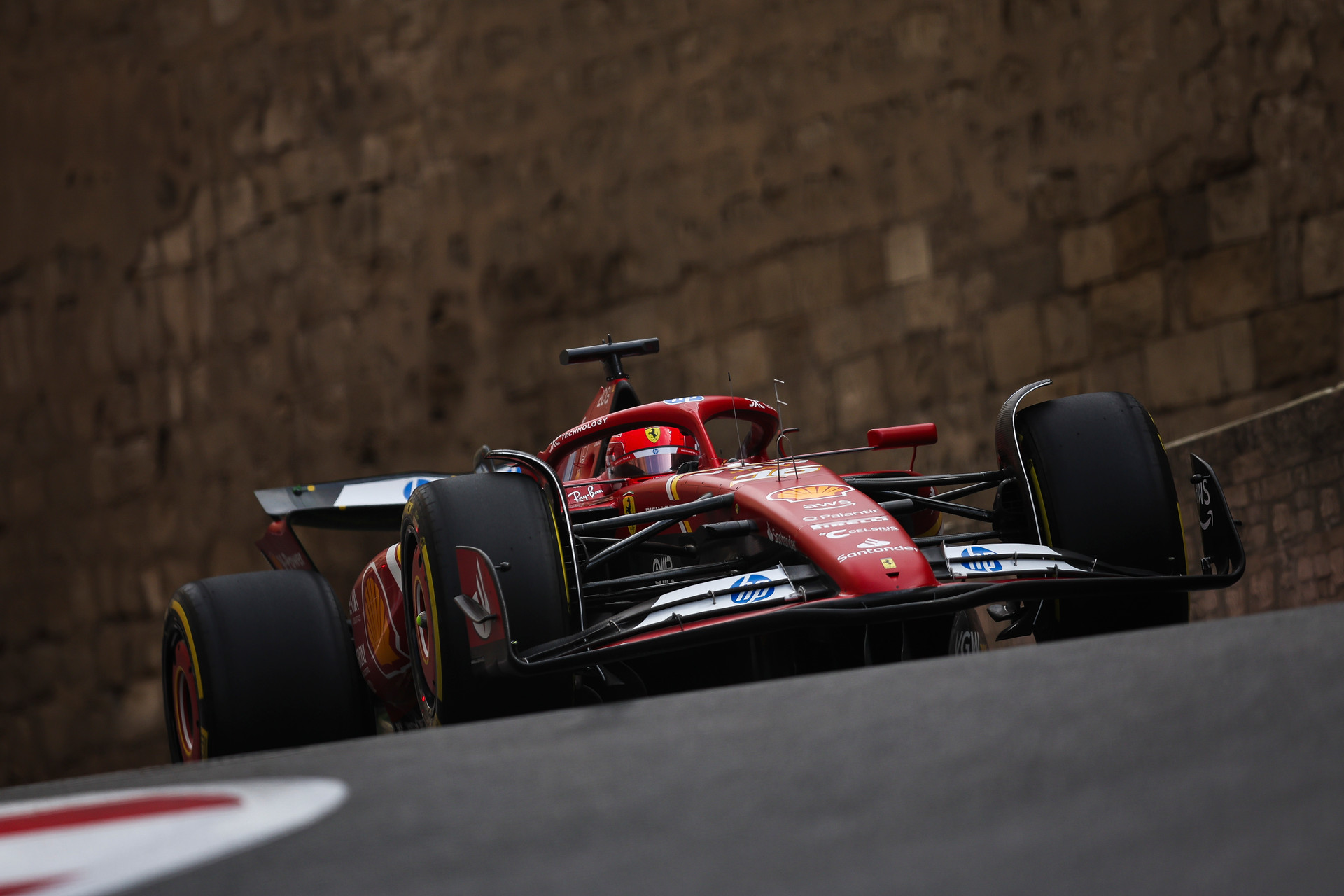Ferrari SF-24: "slow introduction" and dirty air, details of a disappointing defeat at Baku City circuit

09/16/2024 10:52 AM
Ferrari missed out on a great opportunity to secure another race win, with Charles Leclerc unable to cross the finish line first in the Azerbaijan Grand Prix due to small but significant factors. In the opening phase of the Baku race, Charles Leclerc had a clear advantage thanks to the superior grip of the Medium tires compared to Oscar Piastri. However, in the second stint on Hard tires, the dynamics shifted as the Australian displayed better traction. From that point, the race became more about cornering, with Charles Leclerc also losing ground in braking. The Australian consistently gained about a tenth of a second in acceleration and four-tenths overall between the first and second sectors.
Despite the fact that Charles Leclerc stayed close using the drag reduction system on the main straight until the final laps, the rear tires on his Ferrari began to deteriorate due to overheating. Meanwhile, Carlos Sainz’s race was effectively ruined after a major collision with the Red Bull RB20 of Sergio Perez. Carlos Sainz had been making a strong recovery in the second stint and was on course for a podium finish, but the incident with the Mexican driver ended his effort and dashed Ferrari’s hopes of gaining crucial points in the Constructors' Championship.
In the first stint, Charles Leclerc built a lead of 6 seconds, averaging around two and a half tenths per lap. The gap widened after the eighth lap as Oscar Piastri, pushing hard to keep up, began to overheat his rear tires. Telemetry revealed that Charles Leclerc built his lead mostly in the first two sectors of the Azerbaijan circuit on the Medium tires.
Oscar Piastri used DRS and slipstream to reach the end of the straight with an 8 kilometers per hour speed advantage. However, in the corners, Charles Leclerc was stronger, especially in braking, where the clean air ahead allowed him to consistently brake later. This edge disappeared in the second half of the race. The overall pace of the other drivers reflected the general standings of the race, with Sergio Perez, having pitted four laps earlier than Carlos Sainz, managing the first stint on Mediums in a way that mirrored the Ferrari driver.
The Mexican driver also built his advantage over Carlos Sainz in the tighter, slower part of the second sector, where the Spaniard lost around three-tenths per lap. Max Verstappen, on the other hand, passed George Russell at the start and maintained a better pace than the British driver, lapping three-tenths faster but losing over a second per lap to Charles Leclerc. The Dutchman’s main issue stemmed from front tire graining.
As for Lando Norris, it was evident that his car had superior straight-line speed, posting top speeds on the long stretches of the track. Alex Albon and Lando Norris both completed almost 40 laps on the Hard tires, a decision that allowed them to finish in the upper positions. Lando Norris's MCL38, in particular, maintained a faster overall pace than Max Verstappen's, using the lighter car to climb from fifteenth to fifth place.
During his 11-lap run on Medium tires, Lando Norris maintained a pace about two seconds faster than his rivals. The young Brit maximized his stint, pushing the tires to their limit with qualifying-like lap times. He was the only driver to experience positive tire degradation. Once on Hard tires, the performance gap between Oscar Piastri and Charles Leclerc leveled out. Their overall pace was similar, but in the final three laps (five if you include the virtual safety car), the Monegasque driver suffered a drop in tire performance that ultimately sealed his fate and forced him to settle for second place in the Azerbaijan Grand Prix.
Telemetry data reveals more about the situation. Charles Leclerc’s out-lap after the pit stop was three seconds slower than Oscar Piastri's, effectively cutting his first stint lead in half. This was a deliberate “slow introduction” strategy in order to avoid overloading the tires, but it allowed Oscar Piastri to close in and mount an attack. In the first two sectors, Charles Leclerc struggled with traction, while Oscar Piastri's McLaren was flawless in this aspect.
Additionally, dirty air reduced Charles Leclerc’s effectiveness in braking, particularly in Turns 1 and 3. The slower corners of the middle sector had less of a negative impact on Ferrari's Number 16, where the gap wasn’t as significant. However, on the main straight, Ferrari's performance was hindered by another issue. The upper flap of Piastri's rear wing showed excessive flexing, allowing him to gain a small DRS-like advantage with a minor gap between the two main profiles, a tactic that can be considered right on the edge of the regulations.
In summary, dirty air took away one of Charles Leclerc's key strengths: his braking ability. Combined with his traction issues and the prolonged laps behind Oscar Piastri, tire temperature management became a major challenge. The Monegasque driver had to repeatedly handle an unbalanced car due to overheating tires. Adding to this was the time lost during his cautious out-lap after pitting, and these cumulative factors ultimately cost Ferrari the victory at the 6.003-kilometre Baku City Circuit, in the 17th round of the 2024 Formula 1 championship.
The post Ferrari SF-24: “slow introduction” and dirty air, details of a disappointing defeat at Baku City circuit appeared first on Scuderia Fans.


